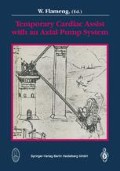Abstract
The preservation of vital organ function appears to be a critical determinant of long-term outcome in patients treated with ventricular assist devices (VAD). Renal failure and multiple organ failure are among the most frequently reported fatal complications during and following temporary mechanical circulatory assist (MCA) (14, 13). Undoubtedly, reversibility of organ dysfunction is primarily determined by the duration of cardiogenic shock which preceeds the initiation of MCA (17). However, changes in regional blood flow distribution due to the use of MCA devices may play an important role as well. Changes in hormonal and neurotransmitter tone have been reported, and it has been clearly demonstrated that MCA alters blood rheology and fluid homeostasis (5, 19). The significance of pulse pressure, the minimum perfusion pressure, and amount of flow delivered by a VAD required to maintain adequate peripheral blood flow remain to be determined. In animals with normal cardiac function, regional blood flow distribution is well maintained with the use of VAD’s (6) The potential of the various types of MCA, however, to restore regional blood flow distribution following a period of critically disturbed and rapidly deteriorating regional blood flow is still controversial. Sukehiro et al. demonstrated that following a period of severe cardiogenic shock, renal blood flow could not be restored to pre-shock values with the use of a centrifugal, non-pulsatile flow VAD (18).
Access this chapter
Tax calculation will be finalised at checkout
Purchases are for personal use only
Preview
Unable to display preview. Download preview PDF.
References
Bush LR, Buja LM, Samowitz W, Rude RE, Wathen M, Tilton GD, Willerson JT ( 1983 Recovery of Left ventricular segmental function after long-term reperfusion following temporary coronary occlusion in conscious dogs. Circ Res 53: 248–263
Dennis C, Hall DP, Moreno JR, Senning A (1962) Reduction of the oxygen utilization of the heart by left heart bypass. Circ Research 10: 298–305
Flameng W, Winkler B, Wuesten B, Schaper W (1977) Minimum requirements for the measurement of regional myocardial blood flow using tracer microspheres. Bibl Anat 15: 24–29
Greenway CV, Stark RD (1971) Hepatic vascular bed. Physiol Rev 51: 23–65
Hung T-C, Butter DB, Kormos RL, Sun Z, Borovetz HS, Griffith BP, Yie C-L (1989) Characteristics of blood rheology in patients during novacor left ventricular system support. ASAIO Transactions 35: 611–613
Johnston GG, Hammill F, Marzec U (1976) Prolonged pulseless perfusion in unanaesthetized calves. Arch Surg 111: 1225–1230
Keppel G (1982) Correction for multiple comparisons. Design and Analysis. Prentice-Hall 144–166
Kobayashi S, Takahashi H, Nishiyama H, et al (1982) Studies on left ventricular bypass: the preventive measure of excess negative pressure upon the inside of left atrium during left ventricular bypass. Jpn J Artif Organs 11: 131–134
Kresh JY, Kerkhof PLM, Goldman SM, Brockman SK (1986) Heart-Mechanical assist device interaction. ASAIO Trans 32: 437–443
Lavallee M, Cox D, Patrick TA, Vatner SF (1983) Salvage of myocardial function by coronary artery reperfusion 1, 2, and 3 hours after occlusion in conscious dogs. Cire Res 53: 235–247
Mackoviack JA, Dasse KA, Poirier VL (1990) Mechanical cardiac assistance and replacement. Heart Transplantation 8: 39–53
Merhige ME, Smalling RW, Cassidy D, Barret R, Wise G, Short J, Wampler RK (1989) Effect of the Hemopump Left Ventricular Assist Device on Regional Myocardial Perfusion and Function. Circulation 80 (Suppl III): III158–III166
Parascandola SA, Pae WE, Davis PK, Miller CA, Pierce WS, Waldhausen JA (1988) Determinants of survival in patients with ventricular assist devices. ASAIO Transactions 34: 222–228
Pennington DG, Kanter KR, McBride LR, Kaiser GC, Barner HB, Miller LW, Naunheim KS, Fiore AC, Willman V (1988) Seven years’ experience with the Pierce-Donachy ventricular assist device. J Thorac Cardiovasc Surg 96: 901–911
Phang P T, Keough K M (1986) Inhibition of pulmonary Surfactant by plasma from normal adults and from patients having cardiopulmonary bypass. J Thorac Cardiovasc Surg 91: 248–251
Richardson PID, Withrington PG (1981) Liver blood flow. Gastroenterology 81: 159–173
Schoen FJ, Palmer DC, Bernhard WF, Pennington DG, Haudenschild CC, Ratliff NB, Berger RL, Golding LR, Watson JT (1986) Clinical temporary ventricular assist. Pathologic findings and their implications in a multi-institutional study of 41 patients. J Thorac Cardiovasc Surg 92: 1071–1081
Sukehiro S, Flameng W (1990) Effects of Left Ventricular Assist for cardiogenic shock on Cardiac function and Organ blood flow distribution. Ann Thorac Surg 50: 374–383
Taenaka Y, Yagura A, Takano H, Matsuda T, Noda H, Kinoshita M, Takatani S, Akutsu T (1988) Altered humoral control of circulating volume during artificial circulation. ASAIO Transactions 34: 692–695
Vanhaecke J, Flameng W, Borgers M, Jang I, Van de Werf F, De Geest H (1990) Evidence for decreased coronary flow reserve in viable postischemic myocardium. Circulation Research 67
Van de Werf F, Vanhaecke J, Jang I-K, Flameng W, Collen D, De Geest H (1987) Reduction in infarct size and enhanced recovery of systolic function after coronary thrombolysis with tissue-type plasminogen activator combined with (3-adrenergic blockade with metoprolol. Circulation 75 (4): 830–836
Wampler RK, Moise JC, Frazier OH, Olsen DB (1988) In vivo evaluation of a peripheral vascular access axial flow blood pump. ASAIO Transactions 34: 450–454
Author information
Authors and Affiliations
Editor information
Editors and Affiliations
Rights and permissions
Copyright information
© 1991 Springer-Verlag Berlin Heidelberg
About this paper
Cite this paper
Wouters, P.F. (1991). Effects of left-ventricular assist using a co-axial flow pump (Hemopump) on organ blood flow during experimental cardiogenic shock. In: Flameng, W. (eds) Temporary Cardiac Assist with an Axial Pump System. Steinkopff, Heidelberg. https://doi.org/10.1007/978-3-662-10284-8_4
Download citation
DOI: https://doi.org/10.1007/978-3-662-10284-8_4
Publisher Name: Steinkopff, Heidelberg
Print ISBN: 978-3-7985-0906-1
Online ISBN: 978-3-662-10284-8
eBook Packages: Springer Book Archive

